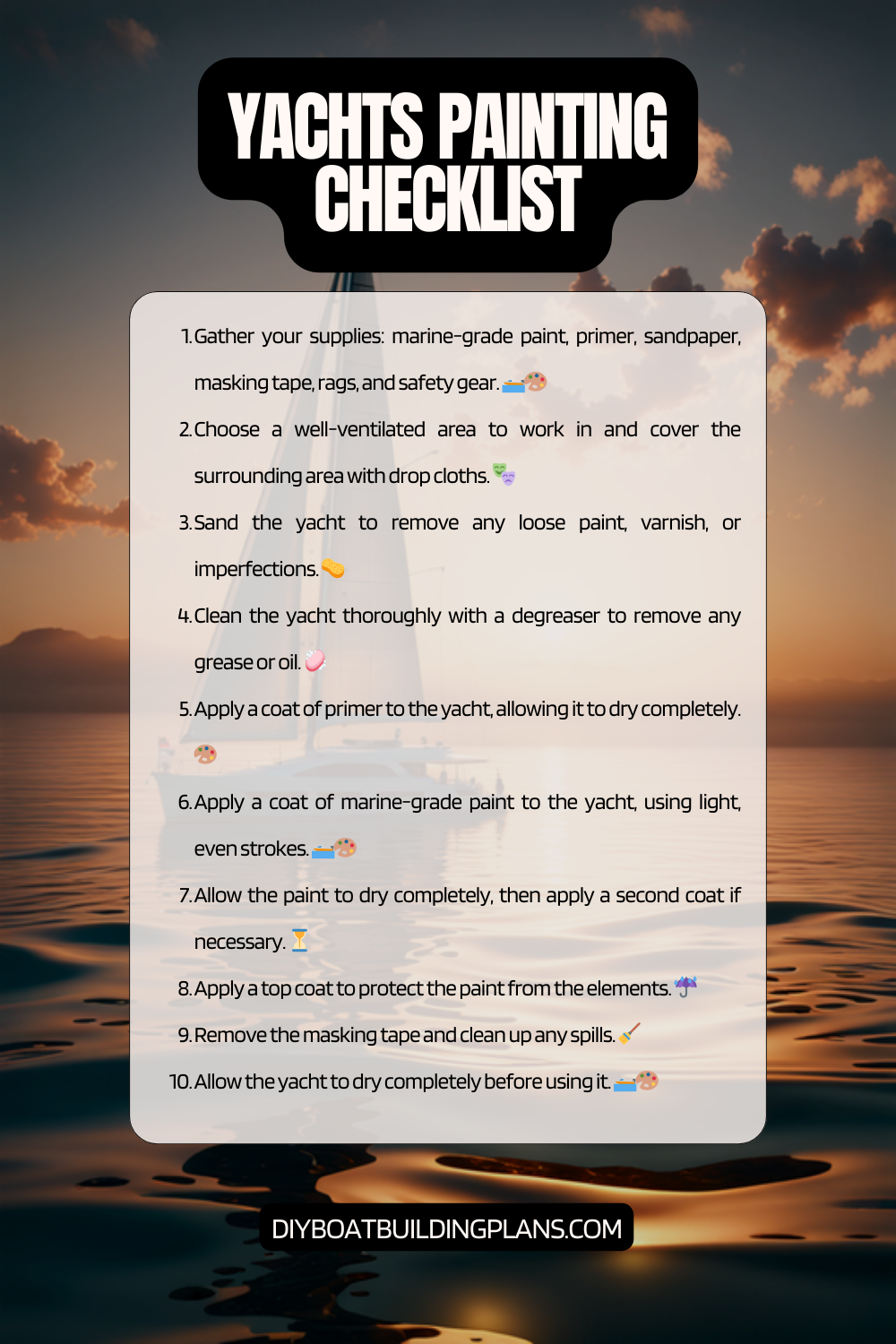Overview of Yacht Painting Tips
Yacht painting is an essential aspect of yacht maintenance and care. A well-maintained paint job not only enhances the aesthetic appeal of your yacht but also protects it from the harsh marine environment. The importance of yacht painting cannot be overstated, as it not only adds value to your vessel but also ensures its longevity.
One of the key benefits of a well-maintained yacht paint job is protection against corrosion and damage caused by saltwater, UV rays, and other environmental factors. The paint acts as a barrier, preventing these elements from penetrating the surface and causing harm to the underlying structure. Additionally, a fresh coat of paint can make your yacht look brand new, increasing its resale value and attracting potential buyers.
Key Takeaways
- Proper preparation is key to achieving a smooth and even finish when painting your yacht.
- Choosing the right type of paint for your yacht depends on factors such as the material of your yacht and the type of water it will be in.
- Understanding the different types of yacht paint, such as antifouling and topside paint, can help you make informed decisions about your paint job.
- Common yacht painting problems, such as blistering and peeling, can be avoided by following proper application techniques and maintenance practices.
- While DIY yacht painting can save money, hiring a professional may be necessary for larger or more complex paint jobs.

Preparing Your Yacht for Painting
Before diving into the painting process, it is crucial to prepare your yacht’s surface properly. This involves cleaning and sanding the surface to remove any dirt, grime, or old paint that may hinder the adhesion of the new paint. Use a mild detergent and water solution to clean the surface thoroughly, followed by sanding to create a smooth and even base.
Repairing any damages is another crucial step in preparing your yacht for painting. Inspect the surface for any cracks, chips, or dents and address them accordingly. Fill in any imperfections with an appropriate filler and sand it down to match the surrounding area. This ensures a seamless finish once the paint is applied.
Masking and covering areas that should not be painted is essential to achieve clean lines and avoid overspray. Use painter’s tape and plastic sheets to protect windows, hardware, and other areas that should remain unpainted. Taking these precautions will save you time and effort in cleaning up later.
Choosing the Right Paint for Your Yacht
Choosing the right paint for your yacht is crucial for achieving a long-lasting and high-quality finish. Several factors should be considered when making this decision, including the type of yacht, its usage, and the desired appearance.
There are different types of yacht paint available in the market, each with its own unique characteristics. Two common types are one-part and two-part yacht paint. One-part paint is easier to apply and dries quickly, making it suitable for DIY projects. On the other hand, two-part paint offers superior durability and resistance to fading and chemicals.
Another consideration is the choice between epoxy and polyurethane yacht paint. Epoxy paint provides excellent adhesion and protection against osmosis, making it ideal for below-the-waterline applications. Polyurethane paint, on the other hand, offers superior gloss retention and UV resistance, making it suitable for above-the-waterline surfaces.
Understanding the Different Types of Yacht Paint
| Type of Yacht Paint | Features | Benefits |
| Antifouling Paint | Prevents marine growth on the hull | Improves fuel efficiency and reduces maintenance costs |
| Topside Paint | Provides a glossy finish on the yacht’s exterior | Enhances the yacht’s appearance and protects against UV rays |
| Bottom Paint | Protects the hull from corrosion and damage | Increases the lifespan of the yacht and improves performance |
| Epoxy Paint | Provides a strong and durable coating | Resists water and chemical damage, and improves the yacht’s resale value |
One-part vs. two-part yacht paint is a common dilemma faced by yacht owners. One-part paint is a single-component product that does not require any mixing or catalysts. It is easy to use and dries quickly, making it a popular choice for DIY enthusiasts. However, it may not offer the same level of durability and longevity as two-part paint.
Two-part yacht paint consists of two components – a base and a hardener or catalyst. These components need to be mixed together before application. The advantage of two-part paint is its superior durability, chemical resistance, and gloss retention. It is commonly used for high-performance yachts or in areas that require extra protection.
When it comes to epoxy vs. polyurethane yacht paint, both have their own set of advantages and disadvantages. Epoxy paint is known for its excellent adhesion and resistance to osmosis, which is the process of water permeating through the hull causing blistering. It is commonly used below the waterline to protect against corrosion and damage.
Polyurethane paint, on the other hand, offers superior gloss retention and UV resistance. It is highly durable and provides a high-quality finish. Polyurethane paint is commonly used for above-the-waterline surfaces, such as the hull sides and superstructure.
Tips for Applying Yacht Paint
Proper application techniques are crucial for achieving a smooth and professional-looking finish. Here are some tips to keep in mind when applying yacht paint:
1. Start with a clean and dry surface: Ensure that the surface is free from dust, dirt, and moisture before applying the paint. This will help the paint adhere better and prevent any imperfections.
2. Use the right tools and equipment: Invest in high-quality brushes, rollers, or spray equipment depending on the type of paint you are using. Using the right tools will ensure even coverage and minimize brush marks or streaks.
3. Follow the manufacturer’s instructions: Different paints have different application requirements, including drying time, temperature range, and number of coats. It is essential to read and follow the manufacturer’s instructions to achieve the best results.
4. Apply thin coats: It is better to apply multiple thin coats rather than one thick coat. This allows for better adhesion and reduces the risk of drips or runs.
5. Maintain proper ventilation: Ensure that you are working in a well-ventilated area to avoid inhaling fumes or harmful chemicals. If working indoors, use fans or open windows to improve air circulation.
6. Take safety precautions: Wear appropriate protective gear such as gloves, goggles, and a respirator to protect yourself from paint fumes and chemicals.
How to Achieve a Smooth and Even Finish
Achieving a smooth and even finish is the goal of every yacht painter. Here are some tips to help you achieve professional-looking results:
1. Avoid brush marks and drips: To avoid brush marks, use long, smooth strokes in one direction. Work quickly and avoid going back over areas that have started to dry. If using a roller, use a high-quality foam roller to minimize texture.
2. Use the right technique: Different painting techniques can be used depending on the type of paint and the desired finish. Some common techniques include brushing, rolling, or spraying. Experiment with different techniques to find the one that works best for you.
3. Allow proper drying and curing time: Follow the manufacturer’s instructions regarding drying and curing time. Rushing the process can lead to premature damage or imperfections in the finish.
4. Sand between coats: If applying multiple coats, lightly sand the surface between each coat to ensure proper adhesion and a smooth finish.
5. Consider hiring a professional: If achieving a flawless finish seems daunting, consider hiring a professional yacht painter. They have the experience, expertise, and equipment to deliver exceptional results.
Dealing with Common Yacht Painting Problems
Blistering, peeling, and fading are common problems that yacht owners may encounter with their paint job. Understanding the causes and solutions for these problems is essential for maintaining a well-painted yacht.
Blistering occurs when water vapor or other substances get trapped beneath the paint film, causing bubbles or blisters to form. This can be caused by moisture in the substrate, inadequate surface preparation, or poor quality paint. To prevent blistering, ensure that the surface is dry before painting and use high-quality paint that is suitable for marine environments.
Peeling is another common issue that can occur when the paint loses adhesion to the surface. This can be caused by poor surface preparation, inadequate priming, or using incompatible paint systems. To prevent peeling, ensure that the surface is properly cleaned and sanded before painting. Use a suitable primer and follow the manufacturer’s instructions for compatibility between different paint systems.
Fading is a natural occurrence due to exposure to UV rays and other environmental factors. To prevent fading, choose a paint that offers UV resistance and regularly maintain and clean your yacht’s paint job. Applying a clear coat or wax can also help protect against fading.
Maintaining Your Yacht’s Paint Job
Regular cleaning and maintenance are essential for preserving the longevity and appearance of your yacht’s paint job. Here are some tips to help you maintain your yacht’s paint:
1. Wash your yacht regularly: Use a mild detergent and water solution to wash your yacht’s exterior regularly. This will remove dirt, salt, and other contaminants that can damage the paint.
2. Avoid abrasive cleaners or tools: Harsh cleaners or abrasive tools can scratch or damage the paint. Use soft sponges or microfiber cloths for cleaning.
3. Wax or polish the surface: Applying a protective wax or polish can help maintain the shine and protect against UV rays. Follow the manufacturer’s instructions for application.
4. Touch up small damages: Small scratches or chips can be touched up using touch-up paint or a small brush. This will prevent further damage and maintain the appearance of your yacht.
5. Inspect for damages regularly: Regularly inspect your yacht’s paint job for any signs of damage, such as peeling, cracking, or fading. Address these issues promptly to prevent further deterioration.
DIY vs. Professional Yacht Painting
Deciding between DIY yacht painting and hiring a professional is a personal choice that depends on various factors. Here are some pros and cons of each option to help you make an informed decision:
DIY Yacht Painting:
– Pros: Cost-effective, allows for customization, can be a rewarding experience for DIY enthusiasts.
– Cons: Requires time, effort, and skill, may not achieve professional results, limited access to specialized equipment.
Professional Yacht Painting:
– Pros: Expertise and experience, access to professional-grade equipment, guaranteed high-quality results.
– Cons: Higher cost, limited customization options, reliance on the schedule and availability of the professional painter.
When deciding between DIY and professional yacht painting, consider your budget, time constraints, skill level, and desired outcome. If you have the necessary skills and resources, DIY painting can be a fulfilling project. However, if you want a flawless finish and peace of mind, hiring a professional yacht painter is the way to go.
Download over 500 Boat Plans. Click on the link below.
-->Click Here<--
Cost Considerations for Yacht Painting
The cost of yacht painting can vary depending on several factors. Here are some considerations to keep in mind:
1. Size of the yacht: The larger the yacht, the more paint will be required, resulting in higher costs.
2. Type of paint: High-quality paints tend to be more expensive than lower-quality options. Consider the durability and longevity of the paint when making your decision.
3. Surface preparation: If extensive repairs or surface preparation is required, it may increase the overall cost of the project.
4. Labor costs: If hiring a professional painter, labor costs will be a significant portion of the total cost. Rates may vary depending on location and expertise.
5. Additional services: Additional services such as sanding, priming, or varnishing may incur additional costs.
On average, yacht painting can cost anywhere from a few thousand dollars to tens of thousands of dollars, depending on the size and complexity of the project. It is essential to obtain multiple quotes from reputable painters and consider the overall value and quality of their services.
Yacht Painting Checklist

Conclusion – Yacht Painting Tips
In conclusion, yacht painting is an important aspect of yacht maintenance that offers numerous benefits. A well-maintained paint job not only enhances the appearance of your yacht but also protects it from corrosion and damage caused by the marine environment.
Proper preparation, choosing the right paint, and applying it correctly are crucial for achieving a smooth and professional-looking finish. Regular maintenance and addressing any issues promptly will help prolong the life of your yacht’s paint job.
Whether you decide to tackle the project yourself or hire a professional, consider your budget, time constraints, and desired outcome. Yacht painting can be a rewarding experience for DIY enthusiasts, but hiring a professional painter ensures high-quality results and peace of mind.
Remember to factor in the cost considerations when planning your yacht painting project. Obtain multiple quotes, consider the overall value of the services offered, and choose a paint that offers durability and longevity.
Maintaining a well-painted yacht not only adds value to your vessel but also ensures that you can enjoy it for years to come. Take pride in your yacht’s appearance and invest in regular maintenance to keep it looking its best.
FAQs – Yacht Painting Tips
What is yacht painting?
Yacht painting is the process of applying paint or coating to the exterior or interior surfaces of a yacht to protect it from the elements and enhance its appearance.
Why is yacht painting important?
Yacht painting is important because it helps to protect the yacht from the harsh marine environment, including saltwater, UV rays, and weather conditions. It also helps to maintain the yacht’s appearance and value.
What are some tips for preparing a yacht for painting?
Some tips for preparing a yacht for painting include cleaning the surfaces thoroughly, removing any old paint or coatings, sanding the surfaces to create a smooth and even surface, and masking off any areas that should not be painted.
What types of paint are used for yacht painting?
There are several types of paint that can be used for yacht painting, including two-part polyurethane, epoxy, and enamel. The type of paint used will depend on the specific needs of the yacht and the desired finish.
How long does yacht painting take?
The length of time it takes to paint a yacht will depend on the size of the yacht, the type of paint used, and the complexity of the job. Generally, yacht painting can take anywhere from a few days to several weeks.
How much does yacht painting cost?
The cost of yacht painting will depend on several factors, including the size of the yacht, the type of paint used, and the complexity of the job. Generally, yacht painting can cost anywhere from a few thousand dollars to tens of thousands of dollars.



